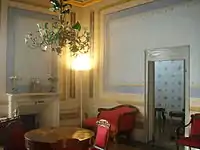Fainting room
A fainting room was a private room, of which its main furniture were fainting couches, used during the Victorian era, to make women more comfortable during the home treatment of female hysteria. Fainting rooms were used for more privacy during home treatment pelvic massages. Such couches or sofas typically had an arm on one side only to permit easy access to a reclining position, similar to its cousin the Chaise longue, although the sofa style most typically featured a back at one end (usually the side with the arm) so that the resulting position was not purely supine.

There are also accounts that mention fainting rooms in eighteenth-century America.[1] This room, which was also referred to as bedroom (bedrooms were called chambers), is located in the ground floor and contained a day bed that allow occupants to rest for brief periods during the day.[1]
Theories for prevalence
One theory for the predominance of fainting couches is that women were actually fainting because their corsets were laced too tightly, thus restricting blood flow.[2][3] By preventing movement of the ribs, corsets restricted airflow to the lungs and, as a result, if the wearer exerted themselves to the point of needing large quantities of oxygen and was unable to fully inflate the lungs, this could lead to fainting. Hyperventilation for any reason could also potentially result in brief loss of consciousness.
Another theory for the predominance of fainting couches is home treatment of female hysteria through manual pelvic massage by home visiting doctors and midwives.[4] As a "disease" that needed constant, recurring (usually weekly) in-home treatment with a procedure that through manual massage could sometimes take hours, creating specialized furniture for maximum comfort during the extended procedure seems likely, as does the later creation of fainting rooms for privacy during the intimate massage procedure.
The Victorian fainting rooms are also associated with gender discrimination such as the claim that it is part of the legacy of female containment where such room served as a deeply female space meant to force women to remain indoors and inactive under the guise of ensuring privacy, class, and interiority.[5] Some also associate it with the view that because women are so frail, they could not handle bad news.[6]
References
- Tometczak, Judith (2017). Haunted Crown Point, Indiana. Charleston, SC: The History Press. p. 79. ISBN 9781467136914.
- Stockdale, Brenda (2009). You Can Beat the Odds: Surprising Factors Behind Chronic Illness and Cancer. Boulder, CO: Sentient Publications. p. 60. ISBN 9781591810797.
- Caiola, Sammy (2015-11-02). "Get skinny in a cinch? Corsets make a comeback, along with health issues". The Sacramento Bee. ISSN 0890-5738. Retrieved 2018-11-14.
- Rachel P. Maines (1999). The Technology of Orgasm: "Hysteria", the Vibrator, and Women's Sexual Satisfaction. Baltimore: The Johns Hopkins University Press. ISBN 0-8018-6646-4.
- Harris, Adrienne; Kalb, Margery; Klebanoff, Susan (2016). Ghosts in the Consulting Room: Echoes of Trauma in Psychoanalysis. Oxon: Routledge. p. 165. ISBN 9780415728676.
- Viti, Lucia (December 30, 2017). "Beauty is pain – but is it torture? Women's Museum of California exhibit explores that question - Beauty is in the eye of the beholder but is it synonymous with pain? Torture? The Women's Museum of California's current exhibit Beauty or Torture: S..." Sand Diego Community News. Retrieved 2018-11-14.
- Greene, Bob (1998-12-12). "Let's all retire to the Fainting Room". Chicago Tribune. Archived from the original on 2007-09-27. Retrieved 2006-08-27.
- Kibbel, Bill. "The Little Room Upstairs". OldHouseWeb. Retrieved 2011-09-03.